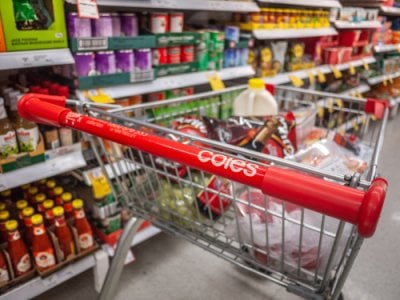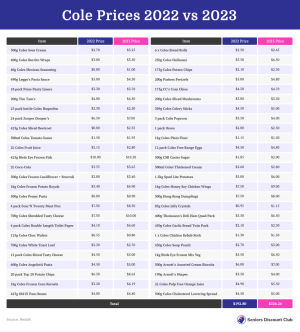Coles receipt comparison highlights unfair reality of today's supermarket prices
Money is tighter than ever, and our members here at the SDC understand it can be tough to stretch your weekly budget, especially when prices for food, essential items and other necessities continually increase.
Just how much have prices gone up? Recently, one Coles shopper did the math to compare a few items on her grocery list to the prices she paid for the same items mere months ago, and the results are quite staggering.
The New South Wales mum compared an online order from late 2022 to current prices on the Coles website, listing 52 products and finding that, on average, individual items had increased in price by 21 per cent, or 64c.
The mum wrote: ‘So because I’m a data-driven wife and mother, who does the groceries, I decided to sit down and compare my online orders with Coles in the second half of 2022 vs prices now on their website. I’m not sure if anyone else finds this interesting (absolutely f*****) but here it is, Coles and their “down down” prices. These increases are in LESS than a year.’
The lowest increase was 5c for a kilo of Coles brand plain flour, while the biggest jump was an eye-watering 194 per cent on a 425g can of the supermarket’s sliced beetroot–now priced at $2.35 compared to 80c nine months prior.
In 2022, the total came to $192.80, but it is now up to $226.24-–an increase of $33.34 or 17 per cent.
The shopper listed big increases in prices for Parkers Pretzels (up 60 per cent) and Coles Choc Wafers (45 per cent).
But even the small increases add up over time—the same shopper found that panty liners were up 20c, ibuprofen had also gone up 20c and a four-pack of Coles brand double-length toilet paper rolls were 50c pricier.
The list, which was shared on social media, has snared the interest of many online users. One user wrote: ‘I still have screenshots of the catalogue from 2018/2019 in my phone. The difference in pricing is just crazy. I'll always remember the toilet paper price was a massive increase–$8.50 to $11.90 in one go.’
‘A lady after my own heart—I myself have gone back in and checked prices on my online orders—because I thought I was literally losing my mind with some of the price differences. The escalation is crazy—and certainly beyond 7-8 per cent “inflation”’, another user commented on the post.
Previously, Coles stated that the war in Ukraine and natural disasters like the New South Wales floods had resulted in price increases for some ingredients. They also cited the rising cost of labour, freight and packaging as contributing factors to the additional costs of processed food items.
In 2022, Coles revealed a $1.04 billion annual profit.
The National Food Supply Chain Alliance—which represents various sectors of the food industry—recently predicted that threats to the domestic supply chain would likely put pressure on grocery prices until the end of 2023, at least.
You can browse the shopper’s complete list here:

Members, we know how important it is to make a careful budget and always strive to get the best value for your money. But at the same time, it’s important to take note of today’s prices and compare them to past prices for more accurate budgeting. That way, you can better anticipate and manage any future price increases.
Did you notice the same trend in your local supermarkets? What item has the largest price increase? Let us know in the comments below!
Just how much have prices gone up? Recently, one Coles shopper did the math to compare a few items on her grocery list to the prices she paid for the same items mere months ago, and the results are quite staggering.
The New South Wales mum compared an online order from late 2022 to current prices on the Coles website, listing 52 products and finding that, on average, individual items had increased in price by 21 per cent, or 64c.
The mum wrote: ‘So because I’m a data-driven wife and mother, who does the groceries, I decided to sit down and compare my online orders with Coles in the second half of 2022 vs prices now on their website. I’m not sure if anyone else finds this interesting (absolutely f*****) but here it is, Coles and their “down down” prices. These increases are in LESS than a year.’
The lowest increase was 5c for a kilo of Coles brand plain flour, while the biggest jump was an eye-watering 194 per cent on a 425g can of the supermarket’s sliced beetroot–now priced at $2.35 compared to 80c nine months prior.
In 2022, the total came to $192.80, but it is now up to $226.24-–an increase of $33.34 or 17 per cent.
The shopper listed big increases in prices for Parkers Pretzels (up 60 per cent) and Coles Choc Wafers (45 per cent).
But even the small increases add up over time—the same shopper found that panty liners were up 20c, ibuprofen had also gone up 20c and a four-pack of Coles brand double-length toilet paper rolls were 50c pricier.
The list, which was shared on social media, has snared the interest of many online users. One user wrote: ‘I still have screenshots of the catalogue from 2018/2019 in my phone. The difference in pricing is just crazy. I'll always remember the toilet paper price was a massive increase–$8.50 to $11.90 in one go.’
‘A lady after my own heart—I myself have gone back in and checked prices on my online orders—because I thought I was literally losing my mind with some of the price differences. The escalation is crazy—and certainly beyond 7-8 per cent “inflation”’, another user commented on the post.
Previously, Coles stated that the war in Ukraine and natural disasters like the New South Wales floods had resulted in price increases for some ingredients. They also cited the rising cost of labour, freight and packaging as contributing factors to the additional costs of processed food items.
In 2022, Coles revealed a $1.04 billion annual profit.
The National Food Supply Chain Alliance—which represents various sectors of the food industry—recently predicted that threats to the domestic supply chain would likely put pressure on grocery prices until the end of 2023, at least.
You can browse the shopper’s complete list here:
Key Takeaways
- A Coles shopper has shared a price comparison of her online orders in late 2022 and mid-2023 to reveal the rising costs of supermarket products.
- The comparison disclosed significant price hikes across food items, health and personal care products.
- Various reasons have been cited by Coles for the increase in costs, including global conflicts, natural disasters impacting ingredients like wheat and soft vegetables, and rising costs of labour, freight and packaging.
- The National Food Supply Chain Alliance forecasted last year that certain challenges and threats to Australia's domestic supply chain will likely continue to cause upward pressure on grocery prices until at least the end of 2023.
Members, we know how important it is to make a careful budget and always strive to get the best value for your money. But at the same time, it’s important to take note of today’s prices and compare them to past prices for more accurate budgeting. That way, you can better anticipate and manage any future price increases.
Did you notice the same trend in your local supermarkets? What item has the largest price increase? Let us know in the comments below!










